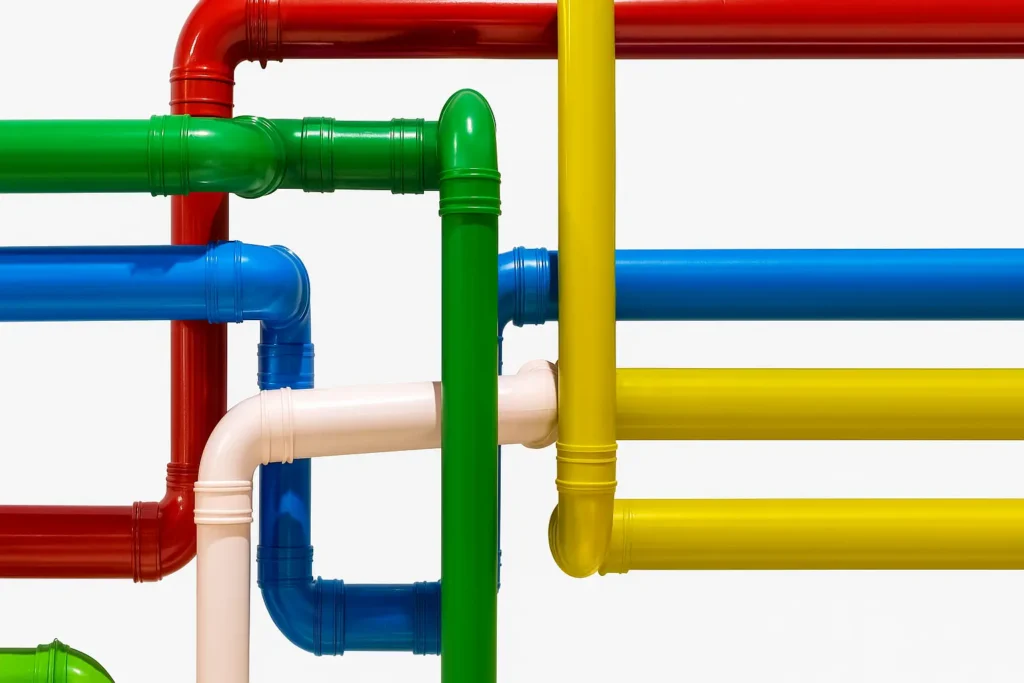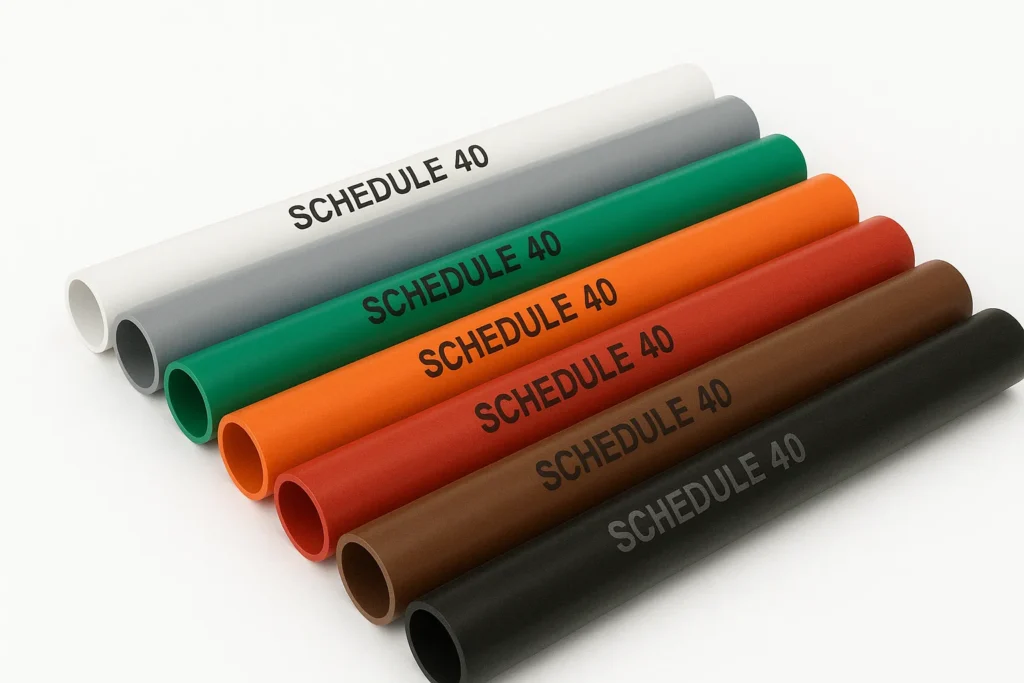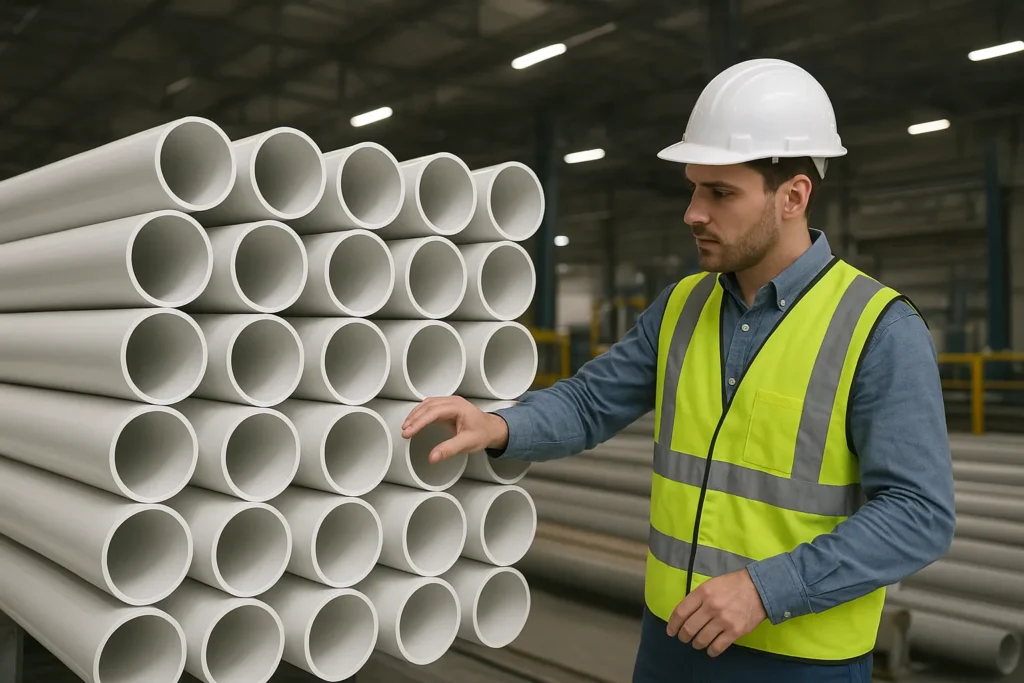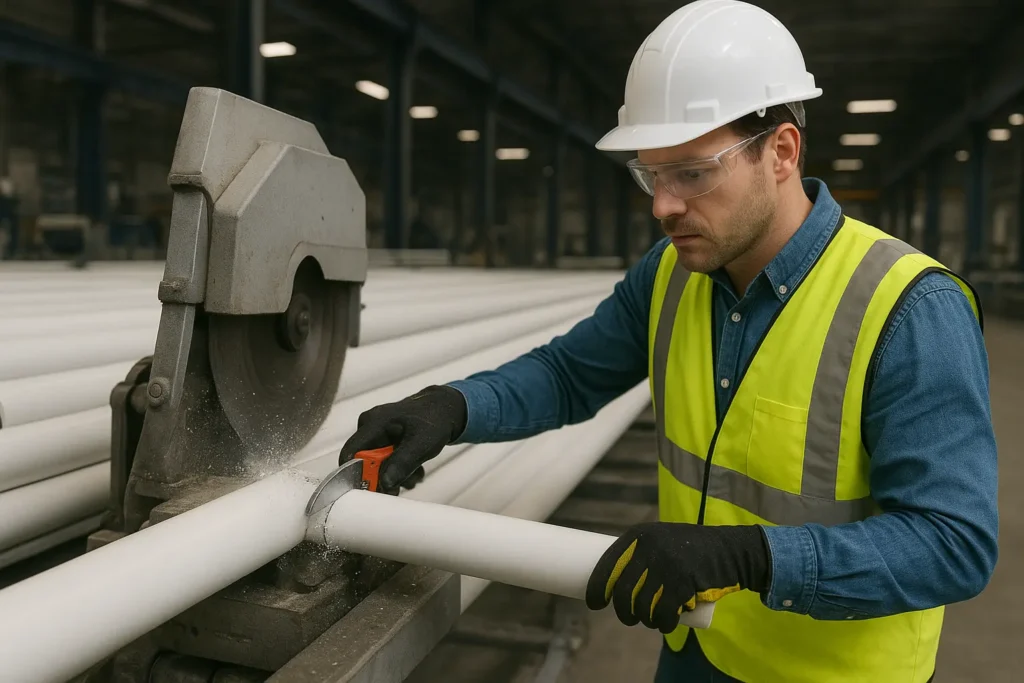PVC Pipe Dimensions – Complete Guide to Dimensions, Types, and Applications
In plumbing, irrigation, or industrial fluid systems, understanding PVC pipe sizes so that an installation can be safe, proper, and cost-effective installation. PVC pipes have been preferred from a construction point of view for their rigidity, high corrosion resistance, and low cost. However, the required sizes pose confusion to many homeowners, contractors, or DIY enthusiasts alike when referring to PVC pipe size dimensions.
In this complete guide, we tried to equip you with all the knowledge concerning the sizes of PVC pipe in mm and inches, how PVC pipe sizing is done, and special cases, such as the introduction of Schedule 80 PVC pipe, smallest PVC pipe and the largest PVC pipe size available on the market.


Understanding PVC Pipe Sizing Basics

While there are materials where the sizes correspond exactly to the inner expanse or outer diameter, it is not true with PVC pipe having sizes. The term ‘nominal size’ mostly refers to some approximate measurement rather than one specific diameter.
So, a ‘1-inch PVC pipe’ may not have a true inner or outer diameter of 1 inch; rather, its actual measure would vary according to its schedule(Thickness) of PVC pipe and its manufacturing standards.
The two standard PVC Pipe Sizes use for dimensions are:
Schedule 40-the most prevalent type used in plumbing, drainage, and irrigation.
Schedule 80-thicker walls for high-pressure tolerance and are used for industrial and heavy-stressed installations.
The two schedules have the same OD for a given nominal size, but they differ in wall thickness and ID.
The two predominant standards used for dimensions of sizes of PVC pipes are:
A Complete Guide to PVC Pipe Sizes, Types, and Uses
Be it for a drainage system, irrigation, or industrial smooth system, it is crucial to explore the PVC Pipe Sizes to ensure safe, appropriate, and cost-effective installation. In terms of construction, you have so much better options with PVC pipes because of their resistance to corrosion, price-point, and strength. Unfortunately, many homeowners, contractors, and do-it-yourselfers often struggle to find the sizes of PVC pipe that they require.
We provide you all the details you need on the sizes of PVC pipes in mm and inches, how to size PVC pipes, and some unique situations like the (new) availability of Schedule 80 PVC pipes and the largest size PVC pipe available on the market as of this writing.
PVC Pipes Sizes Chart
PVC Pipe schedule 40
| Nom. Pipe Size (in) | O.D | Average I.D | Min. Wall | Nominal Wt./Ft. | Maximum W.P. PSI |
| 1/8 | 0.405 | 0.249 | 0.068 | 0.051 | 810 |
| 1/4 | 0.540 | 0.344 | 0.088 | 0.086 | 780 |
| 3/8 | 0.675 | 0.473 | 0.091 | 0.115 | 620 |
| 1/2 | 0.840 | 0.602 | 0.109 | 0.170 | 600 |
| 3/4 | 1.050 | 0.804 | 0.113 | 0.226 | 480 |
| 1 | 1.315 | 1.029 | 0.133 | 0.333 | 450 |
| 1-1/4 | 1.660 | 1.360 | 0.140 | 0.450 | 370 |
| 1-1/2 | 1.900 | 1.590 | 0.145 | 0.537 | 330 |
| 2 | 2.375 | 2.047 | 0.154 | 0.720 | 280 |
| 2-1/2 | 2.875 | 20445 | 0.203 | 1.136 | 300 |
| 3 | 3.500 | 3.042 | 0.216 | 1.488 | 260 |
| 3-1/2 | 4.000 | 3.521 | 0.226 | 1.789 | 240 |
| 4 | 4.500 | 3.998 | 0.237 | 2.118 | 220 |
| 5 | 5.563 | 5.016 | 0.258 | 2.874 | 190 |
| 6 | 6.625 | 6.031 | 0.280 | 3.733 | 180 |
| 8 | 8.625 | 7.942 | 0.322 | 5.619 | 160 |
| 10 | 10.750 | 9.976 | 0.365 | 7.966 | 140 |
| 12 | 12.750 | 11.889 | 0.406 | 10.534 | 130 |
| 14 | 14.000 | 13.073 | 0.437 | 12.462 | 130 |
| 16 | 16.000 | 14.940 | 0.500 | 16.286 | 130 |
| 18 | 18.000 | 16.809 | 0.562 | 20.587 | 130 |
| 20 | 20.000 | 18.743 | 0.593 | 24.183 | 120 |
| 24 | 24.000 | 22.544 | 0.687 | 33.652 | 120 |
PVC Pipes schedule 80
| Nominal Pipe Size (in) | O.D | Average I.D | Min Wall | Nominal Wt./ft. | Maximum W.P. PSI* |
| 1/8 | 0.405 | 0.195 | 0.095 | 0.068 | 1230 |
| 1/4 | 0.540 | 0.282 | 0.119 | 0.115 | 1130 |
| 3/8 | 0.675 | 0.403 | 0.126 | 0.158 | 920 |
| 1/2 | 0.840 | 0.526 | 0.167 | 0.232 | 850 |
| 3/4 | 1.050 | 0.722 | 0.154 | 0.314 | 690 |
| 1 | 1.315 | 0.936 | 0.179 | 0.461 | 630 |
| 1-1/4 | 1.660 | 1.255 | 0.191 | 0.638 | 520 |
| 1-1/2 | 1.900 | 1.476 | 0.200 | 0.773 | 470 |
| 2 | 2.375 | 1.913 | 0.218 | 1.070 | 400 |
| 2-1/2 | 2.875 | 2.29 | 0.276 | 1.632 | 420 |
| 3 | 3.500 | 2.864 | 0.300 | 2.186 | 370 |
| 4 | 4.500 | 3.786 | 0.337 | 3.196 | 320 |
| 6 | 6.625 | 5.709 | 0.432 | 6.102 | 280 |
| 8 | 8.625 | 7.565 | 0.500 | 9.269 | 250 |
| 10 | 10.750 | 9.493 | 0.593 | 13.744 | 230 |
| 12 | 12.750 | 11.294 | 0.687 | 18.909 | 230 |
| 14 | 14.000 | 12.41 | 0.750 | 22.681 | 220 |
| 16 | 16.000 | 14.213 | 0.843 | 29.162 | 220 |
| 18 | 18.000 | 16.014 | 0.937 | 36.487 | 220 |
| 20 | 20.000 | 17.814 | 0.031 | 44.648 | 220 |
| 24 | 24.000 | 21.418 | 1.218 | 63.341 | 210 |
The Basics of Knowing How to Size PVC Pipe
There are some materials where the sizes match up perfectly with the inside or outside diameter. PVC pipe sizes, on the other hand, are not like this. “Nominal size” usually means an approximate measurement instead of a specific diameter.
There are some materials where the sizes match up perfectly with the inside or outside diameter. PVC pipe sizes, on the other hand, are not like this. “Nominal size” usually means an approximate measurement instead of a specific diameter.
A “1-inch PVC pipe” may not have a 1-inch inside or outside diameter. The actual size will depend on the schedule (thickness) of the PVC pipe and the standards used to make it, though.
The walls of Schedule 80 are thicker, so they can handle high pressure. It is used for heavy-duty and industrial installations.
The two main ways to measure the diameters of PVC pipes are:
The most common type for plumbing, drainage, and irrigation is Schedule 40.
The two schedules have the same nominal size, but the thickness of the walls and the ID are different.
PVC Pipe Sizes: Millimeters vs. Inches
PVC pipes are usually measured in inches in the US, but in some other countries, they are measured in mm.
A PVC pipe that is nominally 1 inch in diameter has an outside diameter of about 33.4 mm.
A nominal 2-inch PVC pipe has an outside diameter of about 60.3 mm.
You need to know how to change PVC pipes sizes in mm so that you don’t end up with fittings that don’t fit on global projects.
How to Measure the Size of PVC Pipe?
You need to measure to find out what common PVC Pipe Sizes is best for a job:
The nominal size is the name of the pipe size, such as “3 in.” or “½ in.”
The outer diameter (OD) is the real width of the pipe on the outside.
Wall Thickness—How to find out the pressure rating.
To determine how much flow capacity there is, you need to know the inner diameter (ID) of the following.
The wall thickness means that the inner diameter will always be smaller than the outer diameter – it is bigger with higher schedules, such as Schedule 80 PVC pipe.

PVC Pipe: Schedule 40 vs. Schedule 80
When people are buying PVC pipe, they often assume that Schedule 80 PVC pipe is stronger than Schedule 40 PVC pipe – why?
Wall Thickness: Schedule 80 has thicker walls and is better at handling high pressures.
Schedule 80 pipes are usually gray, and Schedule 40 pipes are usually white.
Uses: Schedule 80 is more commonly used in factories and chemical plants. Schedule 40 is used for plumbing in homes and businesses.
For example:
- The inside diameter of a 2″ Schedule 40 pipe is approximately 2.067″.
- A 2″ Schedule 80 pipe has an inside diameter of approximately 1.939″, due to the wall thickness.
- There are two main standards for the sizes of PVC pipes;
- PVC Schedule 40 Pipe Sizes is the most common type of pipe used for plumbing, drainage and irrigation.
- Schedule 80 has thicker walls, can withstand higher pressure; it is used for installing jobs that are very strength-heavy and happen to be expected to be durable.
- For a certain nominal dimension, the two schedules have the same OD, but their wall thickness and ID are different.
PVC sizes in both inches and millimeters
- Most of the time, PVC pipes in the US are measured in inches, but in some other countries, they are measured in mm.
- A PVC pipe that is nominally 1 inch in diameter has an outside diameter of about 33.4 mm.
- The outside diameter of a 2-inch PVC pipe is about 60.3 mm.
- This means that in global projects, you need to know how to change the sizes of PVC pipes into mm to avoid fittings that don’t fit
Most will argue that Schedule 80 is stronger than Schedule 40 when it comes to PVC pipe fittings because of:
Wall Thickness: Schedule 80 has thicker walls, which can withstand higher pressures.
Color: In that Schedule 80 is mostly gray, and Schedule 40 is mostly white.
Intended Uses: Schedule 80 is used in factories and chemical plants, while Schedule 40 is used in residences and commercial uses.
As such, for example:
A 2-inch PVC Schedule 40 Pipe Size has an inner diameter of about 2.067 inches.
With thicker walls, a 2-inch SCH 80 PVC Pipe Sizes has an inner diameter of about 1.939 inches.
PVC Pipe Sizes in mm – Used Around the World
Many countries, especially in Asia and Europe, sell PVC pipes in sizes that are usually based on millimeters. There won’t be any more signs that say ½ inch, ¾ inch, or 2 inches. PVC Pipe diameter sizes are like 20mm, 25mm, 50mm, and so on instead.
Common PVC Pipe sizes and Fittings are for the outside diameter of the pipe. For instance:
A 20 mm PVC pipe is often used for water supply pipes in homes.
People often use a 50 mm PVC pipe for plumbing in swimming pools or small-scale irrigation.
Sewers and main drainage lines use 110 mm PVC pipe.
When working on projects outside of your home country, you need to know the sizes of PVC pipes in mm so that fittings, couplings, and connectors will fit.
Why is it hard to understand the sizes of PVC pipes?
One would think that the size of PVC pipes is measured the same way as any other round object, by its outer diameter. The nominal size method is based on old standards for steel pipes, when “size” meant the inner diameter at a certain wall thickness.
So, the same sizing rule for PVC means that the nominal size doesn’t always match the real inner or outer diameters. This makes it even harder to choose fittings or replace pipes.
Always check a chart of PVC pipe sizes and measure the outside diameter before you buy.
The largest PVC pipe that is for sale
PVC manufacturing has come a long way, so you can now find pipes that are very big. Most hardware stores only sell PVC in sizes up to 6 or 8 inches, but other businesses get it in much bigger sizes.
In some places, the biggest PVC Plastic Pipe Sizes can be as big as 1200 mm (about 48 inches) across.
These big pipes are used to move water, drain industrial sites, and water crops.
The size is based on how much flow is needed, how much pressure it can handle, and how easy it is to install.
Different sizes of PVC pipes are shown in applications.
PVC pipe sizes in mm and inches are essential for accurate measurement and proper pipe fitting.
- PVC pipes with a small diameter (½ inch to 1 inch / 20mm to 32mm)
- For plumbing and cold water supply inside the house.
- For aquariums and fish tanks.
- For irrigation systems that don’t use much water.
PVC pipes with a medium diameter (1.25 to 4 inches / 40 to 110 mm)
- Garden watering systems.
- The lines for letting air in and out and for draining.
- Plumbing for swimming pools.
PVC pipes with a diameter of more than 4 inches (125 mm)
- Used in factories to move water.
- Sewers and ways to get rid of trash.
- Irrigation is a big part of farming.
- How to Pick the Right Size PVC Pipe for Your Project?
When picking the right size of PVC pipe, you should think
Common Mistakes
As a professional plumber, I saw that even homeowners made costly mistakes due to their unprofessional selecting of PVC pipes. The selection of well-chosen pipes determines the durability, safety, and efficiency of plumbing which otherwise would have also been applied in irrigation or construction. Below are the really most common mistakes that will cause one to choose the wrong pipe.
1. Wrong Pipe Size Selection
One of the worst errors is choosing the wrong diameter of the pipe itself. A pipe that is too small would restrain water flow and cause pressure to build up; a very large one would end up wasting money and space. Requirements of flow and pressure must always be calculated before any decision on the pipe size has been made.
2. Ignoring Pressure Ratings
PVC pipes can be found in various pressure classes or PN ratings. If you use a low-pressure pipe where it should really be of higher pressure, such as in pumping systems, it might lead to cracking, bursting, and leaking. Always ensure that the pipe’s pressure rating fits to the needs of your system.
3. Not Considering Temperature Limits
However, PVC is quite durable and can withstand considerable pressure through internal and external forces, but it shows some temperature limitation. Regular PVC pipe may weaken or warp when subjected to hot water and outdoor heat. If your system contains warm water or is in the sunlight, CPVC or specially UV-resistant PVC should be considered.
4. Using the Wrong PVC Type
PVC pipes are not the same. Schedule 40, Schedule 80, and CPVC serve somewhat different purposes. Many people misapply Schedule 40 for heavy-duty or industrial use. Schedule 80 or CPVC would last safer and longer.
5. Overlooking Chemical Compatibility
Is it fair to say that PVC is largely used in industries and not all chemicals are compatible with PVC? At such low levels of chemical resistance, PVC should not be used for strong acids, solvents, or very high concentrations of chemicals since these could oxidize the compound. Always consult a PVC chemical compatibility chart before installation.
6. Ignoring Joint and Fitting Compatibility
A joint is only as strong as the pipe itself. Improper PVC fittings can lead to leakage or weak joints. Ensure that your fittings correctly match the pipe type and size to avoid problems during installation.
7. Skipping UV Protection for Outdoor Use
Standard PVC can no longer withstand exposure to sunlight for extended periods. One common mistake is the installation of unprotected PVC outdoors, which would result in limited service life. Instead, paint the pipe with UV-resistant paint or use UV-stabilized PVC.
8. Not Consulting Local Plumbing Codes
Every region has its own plumbing code and standards. Using an incorrect pipe type can cause system failure as well as bring legal ramifications or rejected inspections, so make sure to always check your local building codes before purchasing.
Final Thoughts
Choosing the best PVC pipe is more than just reaching for one off the shelf. Through avoiding these common pitfalls-wrong size, type, ignoring pressure, or temperature limits-you can guarantee a plumbing system that will last longer and be much safer.
If you really are not that sure on what to do, it is always best to hire a professional plumber before making that investment.
Frequently Asked Questions – (FAQ’s)
Conclusion
In conclusion, selecting a size for PVC pipe is more than just picking a number on the shelf. It is a great reminder for the user that they should be familiar with the dimensions and ratings to pick the right size pipe for their needs. Precision is key with PVC pipe, whether that be finding the largest size for industrial use or reporting pipe sizes in mm.
It also clarifies that before making any purchases, it is best practice to always check a chart of PVC pipe sizes and measure the outside diameter of your pipe. You will also want to make sure any fittings you buy will fit with the particular system you are building. You can save money, ensure the water flows, and build your system to last for years if you can make accurate representations.
